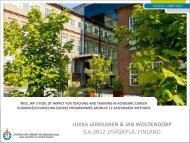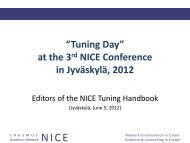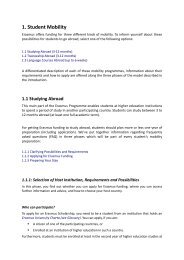NICE HANDBOOK â Academic training of Career ... - Nice-network.eu
NICE HANDBOOK â Academic training of Career ... - Nice-network.eu
NICE HANDBOOK â Academic training of Career ... - Nice-network.eu
Create successful ePaper yourself
Turn your PDF publications into a flip-book with our unique Google optimized e-Paper software.
The findings show that faculty staff have diverse backgrounds and are confident in supportingthe learning process and pr<strong>of</strong>essional values, but also need to update their knowledge <strong>of</strong> technologyand continued academic development. It is notable that faculty engaged in this pr<strong>of</strong>essionaleducation themselves have significant expertise <strong>of</strong> pr<strong>of</strong>essional practice; typically thiswould involve working as a CGC pr<strong>of</strong>essional prior to teaching on the pr<strong>of</strong>essional programmesand <strong>of</strong>ten continuing to combine practice with teaching.It is interesting that these programmes can sit in different faculties with no reported adverseeffects. This implies that the location <strong>of</strong> faculty is <strong>of</strong> no great consequence; but that a <strong>training</strong>team is strengthened by including those with prior pr<strong>of</strong>essional experience in the practice <strong>of</strong>career guidance and counselling.Resource Intensive TeachingMany <strong>of</strong> the fruitful methods reported involve practical work such as interviewing and groupwork. Feedback, both formative and summative, is applauded as a means <strong>of</strong> supporting studentswho are working towards effective pr<strong>of</strong>essional practice during their programmes <strong>of</strong>study. Such feedback tends to the particular and the individual; both <strong>of</strong> which are inherentlyresource intensive techniques. The pointer here is for the use <strong>of</strong> peer review and even peerassessment, and to use <strong>of</strong> ICT applications, where expensive start-up costs are repaid throughextensive use (including podcasts, e-portfolios). Using the NCC plays well here as a solid foundationon which to build pr<strong>of</strong>essional programmes.Pr<strong>of</strong>essional Reflexivity<strong>NICE</strong> HandbookA core message is the importance <strong>of</strong> providing opportunities for reflective learning, and thedevelopment <strong>of</strong> knowledge and skills that is competence-driven, plus an understanding <strong>of</strong>‘theory in action’ and opportunities to practise and engage with pr<strong>of</strong>essional settings. Resourcesthat support this approach must be continually refreshed to ensure currency. Assessmentmodes must enable learners to be actively engaged and to link their pr<strong>of</strong>essional learning tothe required competences. Transparent quality standards are imperative to ensure rigour andconsistency; both are demonstrated. Of course reflective learning and continual pr<strong>of</strong>essionaldevelopment apply as much to the teaching faculty as to the students on their programmes. Acontinuing call is to innovate. This is raised by the challenge <strong>of</strong> how we incorporate technologyinto our curricula, approaches to teaching, learning and associated resources as well as assessmentand how staff are supported in developing their capacity. Whilst there is great emphasison conventional outputs from research undertaken by faculty, there is scope to articulate thebenefit <strong>of</strong> applied research and research derived within a community <strong>of</strong> practice; whether thatis teaching at university level or within pr<strong>of</strong>essional practice in the field or indeed a mixture<strong>of</strong> the two.Networking from University to Field <strong>of</strong> PracticeReferencesArmstrong, S., Chan, S., Malfroy, J., and Thomson, R. (2008): Assessment guide: Implementing criteria and standardsbasedassessment. Sydney, NSW: University <strong>of</strong> Western Sydney.Biggs, J. (2003): Teaching For Quality Learning at University. Wiltshire, UK: Society for Research Into Higher Educationand Open University Press.CEDEFOP (2009): “Pr<strong>of</strong>essionalising career guidance”. Luxemburg: CEDEFOPEuropean Commission (2004): European credit transfer and accumulation system (ECTS). Key features. From http://ec.<strong>eu</strong>ropa.<strong>eu</strong>/dgs/education_culture/publ/pdf/ects/en.pdfHandley, K. & Williams. L. (2011): From copying to learning: using exemplars to engage students with assessmentcriteria and feedback. Assessment & Evaluation in Higher Education, 36, 95–108Hendry, G. D., Bromberger, N. & Armstrong, S. (2011): “Constructive guidance and feedback for learning: the usefulness<strong>of</strong> exemplars, marking sheets and different types <strong>of</strong> feedback in a first year law subject.” Assessment & Evaluationin Higher Education, 36, 1–11James, M., Black, P., Carmichael, P., Conner, C., Dudley, P., Fox, A., Frost, D.; Honour, L., MacBeath, J., McCormick, R., Marshall,B., Pedder, D., Proctor, R., Swaffield, S. & Wiliam, D. (2006): Learning how to learn: Tools for schools. ImprovingPractice (TLRP). London, UK: RoutledgeRasmussen, A. & Friche, N. (2011): Roles <strong>of</strong> assessment in secondary education: Participant perspectives”. EducationalAssessment, Evaluation and Accountability, 23, 113–129Schunk, D.H. (2007): Learning Theories: An Educational Perspective (5th Edition), New York: Prentice Hall<strong>Academic</strong> Training ApproachesAs indicated in the introduction, working collaboratively and co-operatively <strong>of</strong>fers the potentialfor enriched learning. Programmes that support opportunities for the development <strong>of</strong> communities<strong>of</strong> pr<strong>of</strong>essional practice, where both staff and learners stay engaged with the widerpr<strong>of</strong>essional community and are supported in their learning, will be beneficial. This points tolooking out from academia to the field and encouraging effective partnerships and <strong>network</strong>sin order to support students as they become effective practitioners, and managers, and facultyas they continue to <strong>of</strong>fer effective education on pr<strong>of</strong>essional programmes.Shay, S. (2008): Beyond social constructivist perspectives on assessment: the centring <strong>of</strong> knowledge. Teaching in Highereducation, 13 (5), 595-605Siemens, G. (2005): Connectivism: A Learning Theory for the Digital Age, International Journal <strong>of</strong> Instructional Technologyand Distance Learning, Vol. 2 No. 1Spitzer Manfred (2006): Lernen: Gehirnforschung und die Schule des Lebens, New York/Heidelberg: AkademischerVerlagWenger, E. (1998): Communities <strong>of</strong> practice: Learning meaning and identity. Cambridge: Cambridge University Press.In this chapter, we analyse current trends and developments in the field <strong>of</strong> career guidance andcounselling to reflect on possible innovations to the academic <strong>training</strong> <strong>of</strong> CGC pr<strong>of</strong>essionals.136 137






